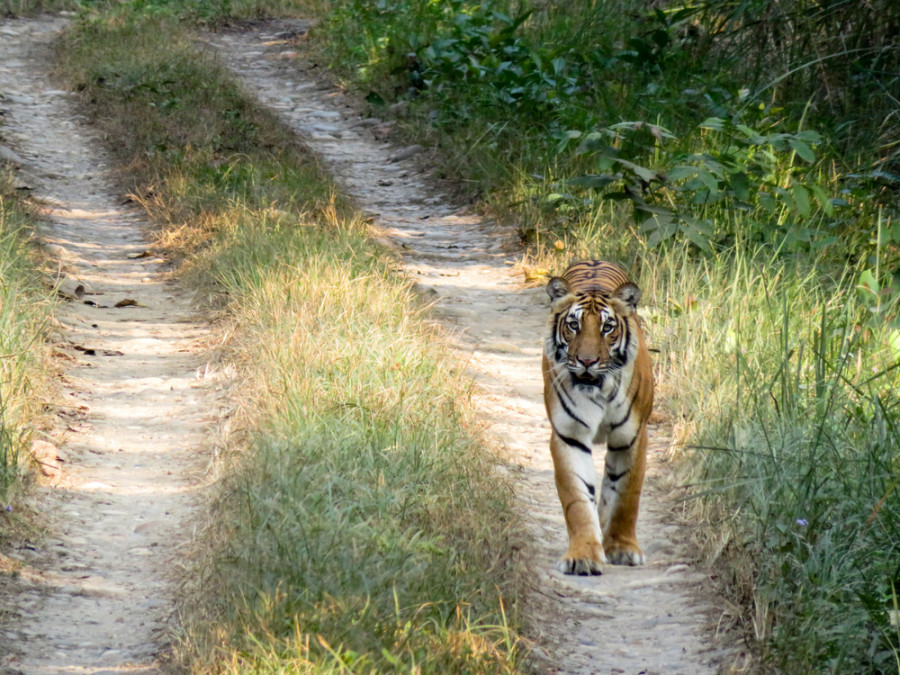National
Tigers that killed two men in Chitwan last month are no longer threats, officials say
While the maneater tiger has been captured and being rehabilitated, wildlife experts have ruled out threats from the second animal that attacked a human deep in the forest.
Chandan Kumar Mandal
The two tigers that killed two men inside Chitwan National Park in September are no longer threats to the villagers living close to the park, officials say .
One of the tigers, a maneater, has been captured while the second tiger attack incident officials have ruled it as an accidental case where the victim had ventured deep in the tiger’s territory.
On September 26, a tiger from the park had killed a 65-year-old man who had gone to cut grass at Belsahar Community Forest. Two days later, on September 28, another man was also killed in a similar incident by another tiger at Kumroj Buffer Zone Community Forest.
The two back-to-back incidents of tiger attack had terrorised the people.
Following the tiger attacks, the park’s authority and Biodiversity Conservation Centre at Sauraha had started monitoring the two tigers to study their behaviours using a camera trap method.
The first tiger that killed a man at Belsahar forest was located and captured after officials found out that it had turned into a maneater as it had become too frail to be able to hunt its usual prey.
Officials believe that the same tiger had killed another man two weeks before the September 26 incident.
The tiger is being rehabilitated at the park’s headquarters in Kasra.
“The tiger is being fed enough meat and treated in a controlled environment. We are also observing its behaviour,” said Ashok Kumar Ram, information officer at the Chitwan National Park. “We need to wait and see how it recovers in the days to come.”
The park has not yet decided whether to release the tiger in the wilderness.
“Once the tiger regains its health, the standard practice is to release it to its habitat. But we need to monitor this tiger’s behaviour since it is a maneater. If the animal fails to regain its strength, there is a risk of it attacking humans again. There is also the risk of it getting killed in a territorial fight with other tigers.”
Officials also said the tiger attack at Kumroj forest was an accidental case and that the risk of the animal attacking other humans is low.
According to Baburam Lamichhane, chief of the Biodiversity Conservation Centre, the incident at Kumroj forest resulted after the victim had gone into the tiger’s territory to collect grass.
The monitoring team found that the tiger had apparently perceived a threat from the man who got too close while it was feeding on a deer carcass.
“Through the monitoring, we wanted to know what was the reason behind the killing and whether there was any sign of similar attack by the same tiger,” Lamichhane told the Post from Sauraha over the phone. “After monitoring, we found out that the tiger had attacked the person because it felt threatened as it was feeding on the carcass of a sambar deer nearby.”
According to Lamichhane, with the monitoring they wanted to see whether the tiger could attack other humans and whether the animal was old or injured causing it to become a maneater.
Five cameras were set up to track the tiger. Lamichhane said the camera traps had recorded several tigers in the area.
“We matched older pictures of the tiger captured through camera traps in the past around the same area with the new pictures to identify the tiger in question,” he said. “The animal looked healthy and it had no reason to prey on humans. We knew the tiger was not a maneater because it did not eat its human victim. For a tiger, humans are not its natural prey. They eat humans only if they are old or are injured and cannot even prey on livestock.”
Lamichhane also said there is a low risk of the similar incident repeating again since the incident site is a core tiger habitat, far from human settlements.
“The tiger had attacked the man who had ventured deep inside the jungle to cut grass,” said Lamichanne.
Lamichhane has conducted several studies on tigers. One of his studies had analysed characteristics of the problem-causing tigers in Chitwan National Park and found that only 5 percent of the park’s tigers were involved in a conflict with locals. The study had also concluded that transient tigers without a territory or physically impaired animals were more likely to be involved in conflicts with humans and recommended an early warning system to anticipate conflicts before they occur.
“Regular monitoring of such tigers through camera trapping and identification of the problematic tigers can help locals be alert against impending danger,” said Lamichhane. “Such monitoring measures can also aid in either rescuing old or injured tigers and encouraging locals to change their behaviour to remain safe from conflicts with tigers.”




 6.81°C Kathmandu
6.81°C Kathmandu







%20(1).jpg&w=300&height=200)






